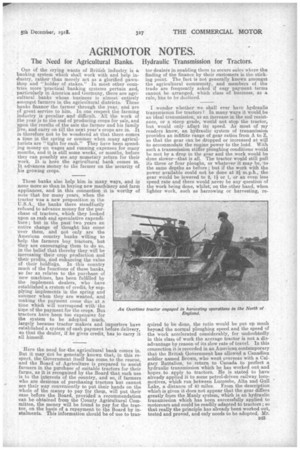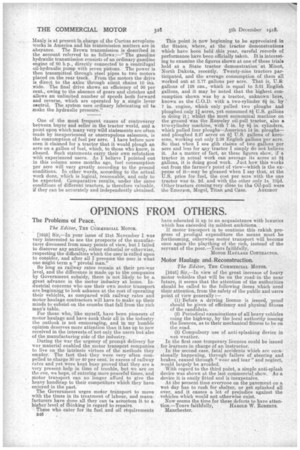• AGRIMOTOR NOTES.
Page 19

Page 20

If you've noticed an error in this article please click here to report it so we can fix it.
The Need for Agricultural Banks. Hydraulic Transmission for Tractors.
One of the crying wants of British industry is a banking system which Ethell work with and help industry, rather than merely act as a glorified pawnkhop and "holder of stakes." In most other countries more practical banking systems pertain and, particularly in America and Germany, there are agricultural banks whose business is almost entirely amongst farmers in the agricultural districts. These banks finance the farmer through the year, and are ot great service to him. In one respect the farming industry is peculiar anddifficult. All the work of the year is to the end of producing craps for sale, and Upon the results of the sale the farmer and his family live, and carry on till the next year's crops are in. It is tlaerefore not to be wondered at that there comes a time in the spring or summer when many agriculturists are "tight for cash." They have been spending money on wages and running expenses for many months, and it is still some weeks*, or months, before they can possibly see any monetary return for their work. It is here the agricultural bank cornea in. It advances money -to the farmer on the security of .his growing crops.
These banks also help him in many ways, and in none more so than in buying new machinery and farm appliances, and in this connection it is worthy of note that for many years, when the tractor was a new proposition in the
U.S.A. the banks there steadfastly refused. to advance money for the purchase of tractors, which they looked upon as rash and speculative expenditure; but in the past two years an entire change of thought has come Over them, and not only are the 'American country banks willing to help the farmers buy tractors, but they are encouraging them to do so, in the belief that thereby they will be increasing -their crop production and their profits, and enhancing the value Of their holdings. In this country much of the functions of these banks, so far as relates to the purchase of new machines, has been fulfilled by the implement dealers, who have established a system of credit; by supplying implements in the spring and summer when they are wanted, and making the payment come due at a time which will correspond with tho time of the payment fer the crops. But tractors have been too expensive for the system to be adopted much, largely because tractor makers and importers have established a system of cash payment before delivery, go that the dealer, if he gives credit, has to carry it all himself.
Here the need for the agricultural bank comes in. But it may not be generally known that, in this respect, the Government itself has come to the rescue, and the Board of Agriculture is prepared to assist farmers in the purchase of suitable tractors for their farms, as it is recognized by the Board that such use is to the interests of the country, and so, if farmers who are desirous of purchasing tractors but cannot see their way conveniently to put their hands on the whole of the money to pay for them, will put their case before the Board, provided a recommendation can he obtained from the County Agricultural Committee, the money will be found to pay for the tractor, on the basis of a repayment to the Board by instalments. This information should be of use to trac tor dealers in enabling them to secure sales where the finding of the finance by their customers is the sticking point. The fact is not generally known amongst the agricultural community, and members of the trade are frequently asked if eau payment terms cannot be arranged, which class of business, as a rule, has to be declined.
I wonder whether we shall ever have hydraulic transmission for tractors? In many ways it would be an ideal transmission, as an increase in the soil resistance, or a steep grade' would not stop the tractor, but would only affect its speed. As most of my readers know, an. hyllraulic system of transmission provides an infinite range of gear ratios from A to Z, so that the gear can be dropped or increased at will to accommodate the engine power to the load. With such a transmission stiffer ploughing conditions would be met by a drop in the gear and the work would be done slower—that is all. The tractor would still pull its three or four ploughs, or whatever it may be, .to the same depths as before; but if the work with the power available could not be done at 2i m.p.h., the gear would be lowered to 2, l or 1, or an even less speed rate and there would never be any question of the work being done, whilst, on the other hand, when lighter work, such as harrowing or harvesting, re quired to be done, the ratio would be put up much beyond the nornaal ploughing speed and the speed of the work accelerated considerably, for undoubtedly. in this class of work the average tractor is not a disadvantage by reason of its slow rate of travel. In this connection it is recorded in an American contemporary that the British Government has allowed a Comedinn. soldier named Brown, who went overseas with a Calgary Battalion, to return. to Canada to perfect a hydraulic transmission which he has worked out and hopes to apply to tractors. He is stated to have already applied it to some petrol-driven railway locomotives, which run between Lucombe, Alta and Gull Lake, a distance of 40 miles. From the description which is given it does not appear that the gear differs greatly .from the Manly system, wIsieh is an hydraulic transmission which has been successfully applied to motorcars and could be readily adapted to tractors ; so that really the principle has already been worked out, tested and proved, and only needs to be adopted. Mr. Manly is at present tn charge of the Curtiss aeroplane works in America and his transmission matters are in abeyance. The Brown transmission is described. in the account referred to as follows :—" The gasoline hydraulic transmission consists of an ordinary gasoline engine of 80 h.p., directly connected to a centrifugal oil-hydraulic pump with seven pistons. The power is then transmitted through steel pipes to two motors placed on the rear track. From the motors the drive is direct to the axles through silent chains 10 ins. wide. The final drive shows an efficiency of 90 per cent., owing to the absence of gears and clutches and allows an unlimited number of speeds both forward and reverse, which are operated by a single lever control. The system uses ordinary lubricating oil to make the hydraulic pressure."
One of the most frequent causes of controversy between buyer and seller in the tractor world, and a point upon which many very wild statements are often made by inexperienced or unscrupulous salesmen, is the consumption of fuel per acre. I have before now seen it claimed for a tractor that it would plough an acre on a gallon of fuel, which, to those who know, is absurd. Such statements carry their own refutation with experienced users. As I believe I pointed out in this column some months ago, fuel consumption per acre will vary greatly according to the ground conditions. In other words, according to the actual work done, which is logical, reasonable, and only to be expected. Comparative results, under the same conditions of different tractors, is therefore valuable, if they can be accurately and independently obtained. This point is now beginning to be appreciatesl in the States, where, at the tractor demonstrations which have been held .this year, careful records of performance have been officially taken. It is interesting to examine the figures shown at one of these trials held at a State tractor demonstration at Minot, North Dakota, recently. Twenty-nine tractors participated, and the average consumption of them all worked out at 3.77 gallons per acre. That is, U.S: gallons of 128 ozs., which is equal to 3.01 English gallons, and it may be noted that the highest :consumption shown was by a tractor, unknown here, known as the C.O.D. with a, two-cylinder 6i in. by 7 in. engine, which only pulled two ploughs and ploughed only 11 acres, yet consumed 8i U.S. gallons in doing it ; whilst the most economical machine On the ground was the Rumeley oil-pull tractor, also a two-cylinder machine, with 7 in. by 8.11 in. cylinders, which pulled four ploughs—American 14 in. ploughs— and ploughed 2.27 acres on 61 U.S. gallons of kerosene, working out only 2.38 English gallons per acre. So that when I see glib claims of two gallons per acre and less for any tractor I simply do not believe it. As a matter of fact, as these figures show, if a tractor in actual work can average its acres at 2* gallons, it is doing good work. Just how this works out from the farmer's point of view—which is the expense of it—may be gleaned when I say that, at the U.S. price for fuel, the cost per acre with the one tractor was4s. 2d. and with the other only is. 101d. Other tractors coming very close to the Oil-pull were
the Emerson, Mogul, Titan and Case. Acealmorr






















